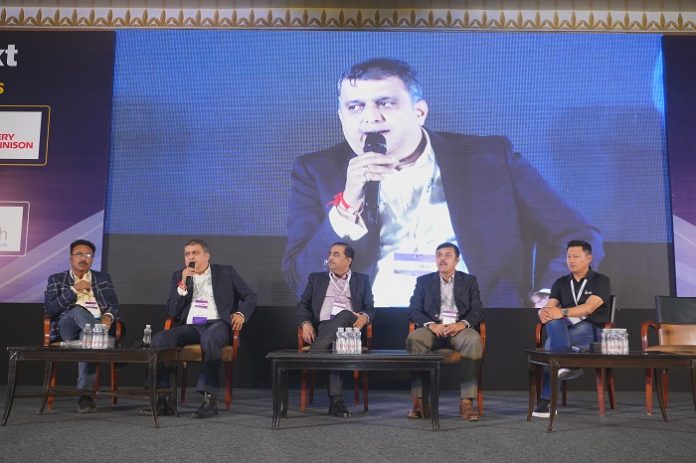
The first panel at PACK.Nxt took on brand protection and authentication in food, alcobev, pharma, FMCG and retail with Kaunain Shahidi of Almarai Foods in Dubai as its moderator. Shahidi approached counterfeiting with a pinch of Chinese (and perhaps also universal) philosophy, dwelling on the twin calamities of discontent and greed. Greed is the primary reason behind the expansion of the counterfeiting industry, he said, adding that it is not merely financial greed but more a lack of emotional intelligence – a matter of heart, personality, thinking and attitude.
Shahidi attributed a great cost to this behavioral shortcoming, citing WHO’s statistics of as many as one million humans dying each year from the consumption of counterfeit pharma products before he called on his panel. Amit Milind Kale, associate vice president – sourcing and supply chain of Reliance Retail, made the case for increased consumer awareness, “For brand protection, it is very important to create understanding among the target buyers about differentiating between authentic and fake brands.” He cited the numerous in-store campaigns to generate consumer awareness run by Reliance in its stores.

Kale suggested that the FMCG and retail industries need government support to generate greater consumer awareness. “The significance of reading product labels is key,” he said. “Moreover, only educated consumers can make use of anti-counterfeiting measures such as holograms, while there are many uneducated consumers in rural environments who don’t fully grasp these technologies. All the more important to create awareness at the grassroots level on how to differentiate between authentic and counterfeit products.”
Prashant Kumar Gupta, vice-president and chief business officer of Sriram Veritech Solutions, echoing Kale, said the right kind of brand protection solutions need to be integrated at a scale that helps the consumer. The challenge is not only protecting the brand but also educating the customers. “Integrated brand protection solutions in your packaging and supply chain work as a deterrent, which in turn protects customers against counterfeit goods.”
“The alcobev business, being highly controlled and regulated, is a unique segment in the FMCG universe,” said Sanjay Ghoshal, senior general manager and head of packaging at Diageo India. There is substantial control over what you can do for brand protection and cannot do. “We are continuously looking for brand protection solutions that are approved by the local excise authorities and government, and these include covert, overt as well as forensic measures,” he said.
“We have an investigation team that deals with the covert measures to distinguish counterfeit products in the market, while the overt measures are visible on the pack and available for consumers to check the authenticity of the brand. These include color-changing patches and textured labels, which can be felt by touch to differentiate the original pack from the counterfeits. Forensic methods involve going to the lab to check for the authenticity of the actual products. A judicious mix of covert, overt and forensic solutions help to combat counterfeiting in the alcobev segment.”
Ashish Anand, technical director at Linksmart Technologies, said the company had been providing a mix of counterfeiting solutions to many sectors by focusing on non-clonable products and pack identifiers over the last decade. “Nowadays, the biggest threat (to consumer product companies) comes from insiders who can easily manipulate the multiple layers of security used by brands including high-security printing, holograms, and high-viscosity inks. The brands are, thus, blackmailed by their own supply chain agencies, and ground investigation agencies. The consumers are left confused as holograms (and other brand protection measures) appear on both authentic and fake products.”
Packaging is a segment where consumers are going to see many changes and RFID is going to play a huge part in this revolution, said Tirthankar Kshetrimayum, tech marketing lead, RFID solutions of Avery Dennison India. “In this digital age, we need to make sure that every physical asset has a digital identity as we need to monitor the lifecycle of the product from a supply chain, productivity, and sustainability point of view. These are exciting times as we are going to see multiple technologies that enable visibility and traceability.”
Kshetrimayum took the example of Amrut Fusion X whiskey, which uses RFIDs for brand protection and authentication. The 10th special rare limited edition of Amrut Fusion X Indian whiskey comes with an integrated NFC chip that not only adds a greater level of safety to the collectible bottle but also links customers to an array of information about the whiskey on its website.
Brands need to educate customers between look-alikes, “genuine fakes” (which resemble genuine products), and genuine products, Kale said. “We need to understand consumer mentality and focus on consumer awareness, and then decide on an authentication methodology,” he added.
Diageo’s Ghoshal said that brand protection solutions need to be easily identifiable. Brand owners need to focus on the lifecycle management of counterfeiting solutions as counterfeiters are always going to be smarter than brand owners as they are not operating within any framework of compliance and the scale of counterfeits could even be larger than the genuine products in the market, although the data in this area is not available. “Brand owners should keep on moving from solution to solution and keep on staggering the ladder to make it more difficult for counterfeiters to replicate the original product(s).”
Anti-counterfeiting happens begins with the correct design, interjected Gupta. The design of the brand protection solution should be robust enough to work for a number of years till the brand owner decides to upgrade the solution. “Counterfeiters go after the lowest hanging fruit, that is, the brands or packs which are unprotected, as these make for easy targets. Brands are not doing enough to make sure that there are deterrents in place so if someone thinks of counterfeiting the products he/she has to make an extraordinary effort to produce fake products.” Designing a solution where the identification, authentication and verification are kept in mind is the need of the hour, he added.
Shahidi echoed the panel’s suggestion that the industry needs to work collaboratively to deploy robust anti-counterfeiting solutions in a multilayer approach. Security, sustainability and cost-effectiveness are the three pillars on which a counterfeiting solution must be based. A powerful ecosystem of technology, enforcement and policies is needed to win the battle against counterfeiting, he added. He cited the Authentication Solution Provider’s Association (ASPA) and Crisil’s data that almost 27% of consumers are unaware they are purchasing a counterfeit product.
In conclusion, Shahidi quoted the late APJ Abdul Kalam, “Where do the evils like corruption arise from? They come from never-ending greed. The fight for a corruption-free and ethical society will have to be fought against this greed and replaced by the spirit of – what can I give?”








